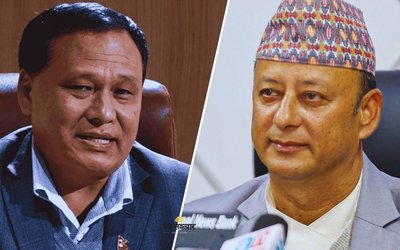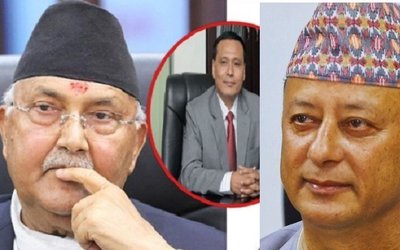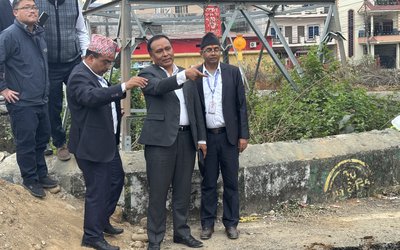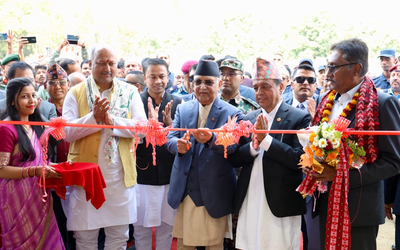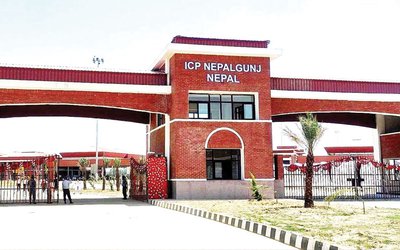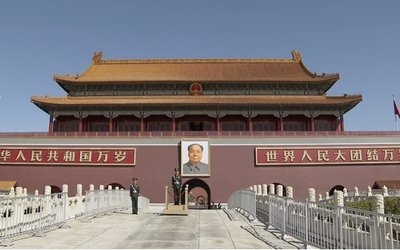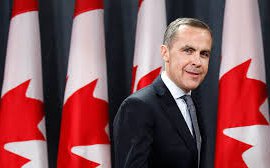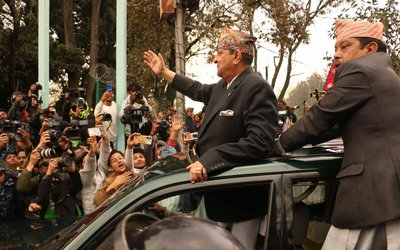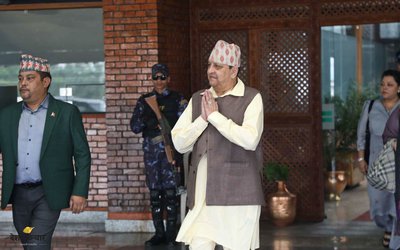
The construction of the 216 MW UT-1 hydropower project is now expected to take a few more years. The foundation stone was recently laid by Shakti Bahadur Basnet, the Minister for Energy, Water Resources and Irrigation, in the presence of senior officials from the Ministry of Energy, the Nepal Electricity Authority (NEA), the Korean Ambassador to Nepal, a high-level delegation of Korean investment, private sector, and other former senior officials.
After nearly seven to eight years of stalling due to indecision by the Ministry of Power's policymakers, the UT-1 project, strategically valuable and highly profitable for NEA, was finally revived in 2018 thanks to a decision made by three powerful individuals.
Then Power Minister Janardan Sharma Prabhakar, Power Secretary and Chairman of the NEA Board Anup Kumar Upadhyaya, and NEA Managing Director Kul Man Ghising jointly made the decision, breathing new life into UT-1 and placing it in its current stage.
Minister Sharma, Secretary Upadhyaya, and MD Ghising demonstrated the impact of a decisive and efficient decision-maker on projects.

Their sound reasoning for favoring the UT-1 project stems from its potential to provide NEA with nearly 39% of free energy after production. In a scenario where no foreign or private investment project offers such a significant amount of free energy to NEA, UT-1 proves to be highly advantageous for Nepal.
Despite the promising financial offer, Korean investors and a Nepali investor sought for favorable results from government offices until 2018.
Ultimately, Sharma, Upadhyaya, and Ghising intervened and acted as saviors, materializing the project and lifting the spirits of the investors. While Nepali investor Bikesh Pradhananga has a 10 percent stake, he fully backed the Korean investors during challenging times.
"We began our journey on April 2, 2012 in Nepal and have since dedicated years to establishing our brand, now synonymous with our unwavering commitment. Our project has always been a collaborative effort, not the work of a solitary individual." "This project is a major milestone for Nepal and will play a crucial role in eliciting enhanced foreign direct investment in the country's hydropower sector," stated Tae Hak Yoon, CEO of Nepal Water and Energy Development Company (NWEDC), upon the successful commissioning of the project.
To demonstrate the ministry's unity in completing the project on schedule, Energy Secretary Dinesh Kumar Ghimire and NEA Managing Director Kul Man Ghising attended the inauguration.
Former Secretary Upadhyaya, who shared his experience of how a crucial decision rescued the projects in the interest of the country, also attended the foundation stone laying ceremony.
South Korea is involved in Nepal's hydropower.

After completing two successful hydropower projects - the 30 MW Chamelia in Sudur Paschim and the 12 MW Modi in Gandaki Province - the Korean government has initiated support for two additional projects, intending to transform Nepal's two provinces into major hubs for hydropower construction and economic growth, ultimately benefitting the local population.
Several additional hydropower projects are currently under construction in Rasuwa. However, UT-1 is expected to have a significant impact on the well-being of indigenous and economically disadvantaged individuals, as well as bolstering Nepal's clean energy capabilities.
Ambassador Park Tae-Young of the Republic of Korea shared his thoughts during the inauguration.
"The UT-1 project is the third hydropower project in Nepal, following projects in Chamelya in 2018 and Modi Khola in 2000," stated the speaker. This investment by Korean companies not only improves Nepal's economy, but also serves to strengthen the friendly relations between our two nations." South Korea ranks as Nepal's fourth investment partner, following China, India, and the United States. "I appreciate the Honorable Prime Minister's vision and leadership in transforming Nepal into a foreign investment-friendly destination. This vision has the potential to be realized in the near future. In this regard, I believe that Korea could be a strong ally (RamroSaathi) for foreign investment in Nepal's energy sector," stated Ambassador Park Tae-Young (see box).
History of UT-1
The Korean delegation came to Nepal in 2012, having made an agreement to invest in the UT-1 project. It was initially announced that the project would be completed by April 2019. However, the signing of the Power Development Agreement (PDA) was delayed, amongst other issues, due to a major earthquake in 2015. It was eventually signed in 2016, and the PPA was completed in 2018. Financial management was concluded a year later in 2019.
Subsequently, the groundbreaking ceremony took place in September 2023, although the work on the project actually commenced in 2022. The construction of the main components of the project is currently underway, with active work ongoing on the excavation of the underground powerhouse and headrace tunnel. Progress is being made in all areas, with an overall rate of 22 percent.
The construction of structures such as dams is currently taking place in Amachhodingmo Rural Municipality-1 Haku of Rasuwa. In addition, a project to build an underground power house is currently being executed in Uttargaya Rural Municipality-1.

The UT-1 project has completed several crucial preliminary tasks. A diversion tunnel was constructed for UT-1, a run-of-the-river hydropower project, a year ago. Since then, the project has intensified with heightened construction. As the largest hydropower project currently under construction with foreign direct investment for domestic use, UT-1 is a significant undertaking.
The construction project has achieved a major milestone by completing a 420-meter long diversion tunnel lined entirely with concrete, featuring a diameter of five meters. The project diverted the Trishuli River through the newly constructed tunnel to enable the construction of the headworks.
Tae Hak Yoon, the CEO of Nepal Water and Energy Development Company (NWEDC), expressed his satisfaction with the river diversion, noting it as a significant accomplishment in the development of UT-1.
The project has achieved significant progress by excavating 4.5 km of the 13.5 km tunnel that comprises the headrace, adit and tailrace tunnels.
The excavation of the underground powerhouse has also advanced, with project progress surpassing 30 percent. The project is slated for production by December 2026, following its commencement in January of 2022.
UT-1 is a ROR scheme, with a total annual gross energy production of 1533.06 GWh. The project comprises a 29.5 m high dam, an underground sand trap, a 9.8 km long headrace tunnel (HRT), a surge tank, and an underground powerhouse as its main structures.
The total project cost of USD 647.34 million, including interest during construction, will be financed by 70 percent debt and 30 percent equity. The project partners will contribute an equity investment of USD 194.20 million.
A loan of $453.12 million is being provided by international lenders, which include the International Finance Corporation (IFC), Asian Development Bank (ADB), Korean Exim Bank (K-EXIM), Korean Development Bank (KDB), Asian Infrastructure Investment Bank (AIIB), FMO (The Netherlands), British International Investment (BII), Proparco (France), and the OPEC Fund for International Development (OFID).
The NWEDC is the company that will operate the project. NWEDC shareholders consist of Korea South-East Power Co. (KOEN), Korea Overseas Infrastructure and Urban Development Corporation (KIND), International Finance Corporation (IFC), a World Bank Group member, and domestic investors.
The project is being developed on a build-own-operate-transfer (BOOT) basis under a project development agreement signed with the Government of Nepal in December 2016.
Of the entire yearly energy produced by the project, 38.75% will be produced in the dry season, surpassing most other hydropower projects in Nepal that rely on river flow. Of the entire yearly energy produced by the project, 38.75% will be produced in the dry season, surpassing most other hydropower projects in Nepal that rely on river flow. This information was given in a press release released by NWEDC. UT-1 is anticipated to deliver a maximum of 1,533 GWh of electricity.
NEA has committed to buy all of Upper Trishuli-1's power yield for 30 years under a power purchase agreement (PPA) signed with NWEDC in January 2018.
Project Vision.
"We have overcome various challenges to arrive at this stage in the project's development. "We have overcome various challenges to arrive at this stage in the project's development. Our vision for the hydropower industry is precise. Through the production and distribution of energy to the Nepalese government, we actively contribute to improving Nepal's economy," commented CEO Tae Hak Yoon.
"We are a subsidiary of Korea South East Power Company Limited (KOEN), a top power generation company in South Korea with 9,175 MW of power generation capacity, equivalent to 10.7% of the country's total capacity.
To aid Nepal in its energy issues, KOEN, KIND, IFC, and the local promoter made the decision to invest in Nepal. The Nepalese government actively supports the development of hydropower." Developing hydropower is a priority for us, with a strong emphasis on environmental, social, and rural concerns.
Minister Basnet has requested investment from Korea.
Shakti Bahadur Basnet, Minister for Energy, Water Resources, and Irrigation, met with Hoe-Chun Kim, President and CEO of Korea South-East Power (KOEN). The minister urged the Korean investor to invest in Nepal's hydropower sector.
KOEN is the primary backer of the UT-1 project. Minister Basnet hopes to attract more Korean investors to the sector.
According to Minister Basnet, Nepal enjoys cordial and friendly bilateral relations with South Korea, highlighting the potential benefits of Korean technology and skills.
The Minister assured the KOEN Chairman during the meeting of the Government's full support for the smooth implementation and timely completion of the Upper Trishuli Hydropower Project.
As Minister of Forests and Environment, he facilitated UT-1 and made timely decisions concerning forest-related issues.

Hoe-Chun Kim, CEO of Korea South-East Power (KOEN) and leading investor in the project, emphasized using Nepal's water resources to increase domestic consumption of renewable energy and export surplus electricity to neighboring countries for economic growth and mitigating climate change.
"During my return, I aim to promote additional Korean investment in Nepal," stated President Kim to Minister Basnet.
He ensured that they would endeavor to finalize the project promptly, despite the recent groundbreaking ceremony.
At the Upper Trishuli 1 (UT-1) Hydropower Project's foundation stone laying ceremony, Minister Basnet urged for timely completion of the project and guaranteed essential facilitation and coordination."
Minister Basnet stated that the country's electricity demand will reach approximately 15,000 MW over the next 12 years.
Hoe-Chun Kim, the President and CEO of Korea South-East Power (KOEN), remarked that Nepal's abundant water resources, coupled with a boost in domestic use of eco-friendly energy, and export of surplus power to neighboring nations, has significantly contributed to achieving economic prosperity while diminishing climate change consequences.
He stated that the project is crucial to meet the rising demand for domestic electricity, particularly during Nepal's dry season, and to decrease reliance on imported electricity.
South Korean Ambassador to Nepal, Park Tae-Young, conveyed his confidence that finishing the construction of UT-1 will aid in attracting foreign direct investment to Nepal, offering employment opportunities.
Around 1,000 workers are currently employed at the construction site, with roughly 500 of them being local residents from the Rasuwa district affected by the project.
For the duration of the five-year construction period, the project will employ between 700-1000 Nepalese workers. After construction is completed, 70-80 Nepalese workers will continue to be employed during the 30-year operation period.
UT-1 is currently the largest hydropower project under construction with foreign direct investment aimed at domestic consumption. The concession period for the project is 35 years, incorporating a five-year construction period.
The project's total cost, including interest during construction, amounts to $647.4 million and will be financed with a 70 percent debt and 30 percent equity split.
NWEDC's shareholders comprise of Korean Consortium Korean Southeast Power Co (KOEN) at 50%, Daelim at 15%, and Kyeryong at 10%. IFC and Bikesh Pradhanang, a local partner from Nepal, both have 15% of the company's shares.
In the future, communities affected by the project will have the right to apply for a 10% stake in the project.
The project partners will invest USD 194.20 million in equity while the debt of USD 453.12 million will be provided by international lenders such as IFC, ADB, Korean Exim Bank (K-EXIM), Korean Development Bank (KDB), Asian Infrastructure Investment Bank (AIIB), FMO (Netherlands), British International Investment (BII), Proparco (France), and the OPEC Fund for International Development (OFID).
Although the recently introduced social safety policy implemented by the IFC for the project may be complex and lead to some conflicts, it is probable that the project will be finished by December 2026 due to the established commitments of both the developers and the government. The UT-1 project marks the third hydropower project supported by Korea and is expected to significantly improve the living standards of Nepalis.
- MD GHISING: Target Of Personal Grudge
- Mar 09, 2025
- UPPER TRISHULI-1 HYDROPOWER: Supporting Community Development
- Feb 24, 2025
- ADB POWERING NEPAL: Five Decades Of Support
- Feb 24, 2025
- RENEWABLE AND GREEN ENERGY: Challenges To Overcome
- Feb 23, 2025
- KOICA SUPPORT: Migrant To Future Innovators
- Feb 21, 2025
